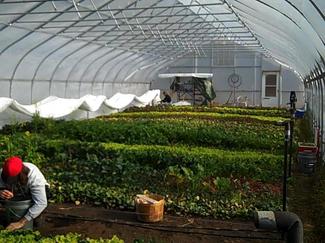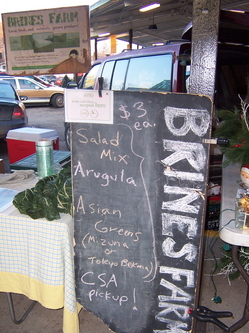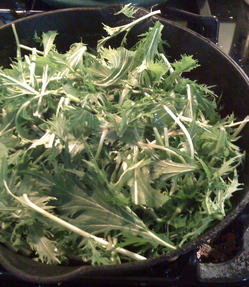Brines Farm brings us fresh greens in the winter
In my Farm to Fork series I visit local farms around Ann Arbor and share what I learn.
 0 00 24-21-thumb-300x225-18671.jpg)
Shannon Brines in his greenhouse.
Corinna Borden | Contributor
It is obvious to me that I wish Ann Arbor were ringed with similar greenhouses filled with fresh lettuce in December. I stopped purchasing lettuce imported from California last year when I did some math. The amount of calorie energy my body receives from eating lettuce in February does not justify to me the amount of fuel it takes to get to my plate.
There is a fascinating article discussing this ratio (energy input: producing, processing, packaging, and distributing vs energy output: calories to the body). I also think that vegetables and fruits grown here taste better than the hardier varieties grown to withstand transport and sitting on the market shelf. True, I still purchase olive oil from Italy, Malbec from Chile, and Telicherry Pepper from India - but I don’t eat bowls of olive oil, Malbec, and pepper everyday - I do eat bowls of vegetables everyday. Big bowls.

Vibrant spring green carpets the soft ground as winter bumped against the greenhouse.
Corinna Borden | Contributor
Shannon Brines described to me how he started. “I was looking around and realized that there really wasn’t anyone delivering anything year round.” He went to workshops, read books, and finally decided to give four-season farming a try when he built his first greenhouse in 2004. He had no experience with such a large scale greenhouse operation, but he decided to "give it a whirl."
I think for many of us building a 90 foot long greenhouse might seem a bit daunting, but as Yoda tells us: "there is no try, there is only do, or do not." Shannon Brines has been doing - since 2004 he has built two more greenhouses. He started selling at the Ann Arbor Market in 2005 and continues to sell at Ann Arbor and the Westside Farmers' Markets. As Shannon tells me, while he harvests delicate yellow-green Tokyo Bekana, “It didn’t take long for people to catch on when they realized I was gonna come in the winter with fresh greens.”

Brines farm at the Ann Arbor Farmers Market.
Corinna Borden | Contributor
The greenhouses are built as a simple metal frame with two layers of plastic on the outside. A small fan pushes air between the two layers to create a layer of air insulation. Row cover fabric is pulled over the plants when the sun goes down as an added layer against the cold. “For the most part it stays above freezing at ground level…the light issue is really the biggest concern. The day gets so short. It is winter.” It may be winter, but inside the greenhouses, with the sun glowing through the layers of plastic, it felt like early May as the warmth crept into my bones.
Brines Farm utilizes organic practices and finds for the most part that insects - both deleterious and beneficial find their way inside the plastic. With the large number of brassicas crop rotation is “a little tricky” so their current modus operandi is to spread a 5 gallon bucket of compost for every 12 foot bed. This practice is recommended by Eliot Coleman and Steve Moore (referred to in this article as the Gandhi of Greenhouses).
I had a chance to do some harvesting of the mizuna, a plant I was unfamiliar with until that morning. I took off my mittens, jacket, hat, scarf, and sweater to kneel down onto the dark earth in the warm humid space. Occasionally the 18 degree wind buffeted the walls, making the plastic bounce. Mizuna is bright green with lacelike leaves. I used paper scissors to easily cut through the tall stalks and place them into a cooler. The leaves were to be cleaned and separated in preparation for the market the next day. Saturday at the market, I was able to purchase a bag of Mizuna to taste the fruit of my efforts.

Mizuna can be lightly cooked or eaten raw in salads.
Corinna Borden | Contributor
The Farm to Fork series focuses on local farms around Ann Arbor. If you would like me to visit your farm drop me a line and say hello. You can also check out my website!


Comments
Foodie01
Wed, Dec 9, 2009 : 11:15 a.m.
After week 2 of the winter CSA with Brines, we could not be happier with the delicious, fresh, locally harvested greens. Having someone focus on four-season farming is a great thing for Michigan locavores. More farmers should follow Brines' lead.